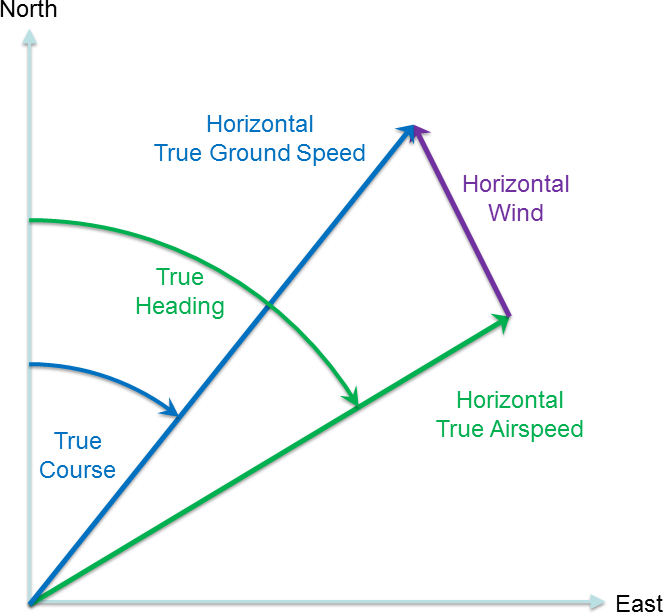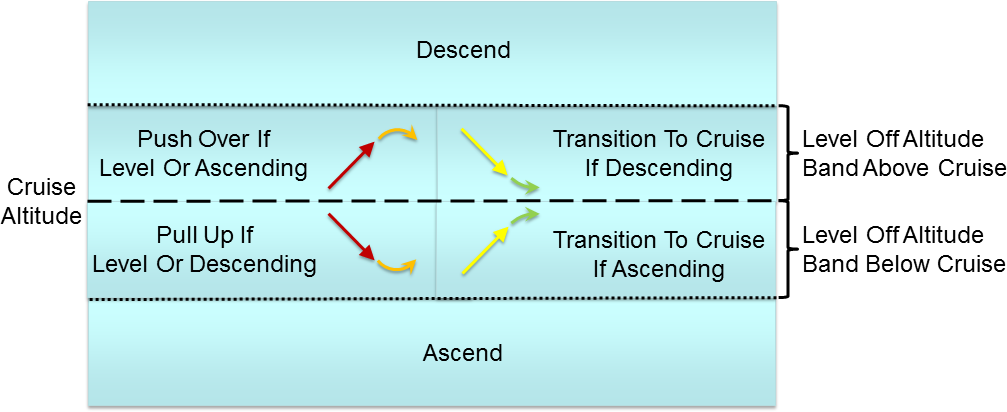Aircraft Maneuvers |
A Maneuver is an action over a span of time which controls the horizontal and vertical motion (track and profile, respectively) of an aircraft.
The functionality described in this topic requires a license for the Aircraft Propagation Library. |
Some maneuvers may be performed relative to either the static atmosphere (in a topocentric reference axes fixed with respect to the rotating Earth) or the moving atmosphere (in a topocentric reference axes moving with the local wind). The following diagram shows the geometry defining the relationships between true course, true heading, and the horizontal components of the velocity triangle:

A maneuver is configured with a wind model and a set of performance models as indicated in the following diagram:

A WindModel defines the local movement of the atmosphere relative to the rotating Earth fixed frame. For example, ConstantWindModel defines the wind in terms of the wind direction (the direction that the wind is coming from) and constant horizontal and vertical speed components of the wind.
The set of PerformanceModels dictate how the aircraft is to move during the various phases of flight (climb, cruise, descent, etc) and provide limits on the motion of the aircraft which govern how quickly the aircraft motion may change.
A CompositeManeuver allows the user to define the motion of the aircraft distinctly as a separate HorizontalBehavior and VerticalBehavior.
A HorizontalBehavior defines the navigational motion of the aircraft and the resulting horizontal track that the aircraft follows. This motion is provided to the CompositeManeuver as a rate of change in either the true course or the true heading of the aircraft, depending on the value of the ManeuverReferenceAxes. The following HorizontalBehaviors are provided:
Horizontal Behavior | Description |
|---|---|
Defines a horizontal behavior of a CompositeManeuver in which a constant course or heading is maintained.
| |
Defines a horizontal behavior of a CompositeManeuver in which a constant turn rate is maintained.
|
A VerticalBehavior defines the forward/backward and upward/downward motion of the aircraft and the resulting vertical profile that the aircraft follows. This motion is provided to the CompositeManeuver as a rate of change in either the true ground velocity or the true air velocity of the aircraft, depending on the value of the ManeuverReferenceAxes. The following VerticalBehaviors are provided:
Vertical Behavior | Description |
|---|---|
Defines a vertical behavior of a CompositeManeuver in which the horizontal and vertical speeds are maintained.
| |
Defines a vertical behavior of a CompositeManeuver in which the direction of flight of the aircraft is either "pushed over" or "pulled up". The TransverseLoadFactor (get / set) determines the rate at which the "push over" or "pull up" occurs.
The LongitudinalLoadFactor (get / set) determines the rate at which the speed of the aircraft changes. | |
Defines a vertical behavior of a CompositeManeuver in which an aircraft accelerates or decelerates longitudinally, linearly increasing or decreasing its true airspeed and rate of climb or descent. The LongitudinalLoadFactor (get / set) determines the rate at which the speed of the aircraft changes. | |
Defines a vertical behavior of a CompositeManeuver in which an aircraft attempts to achieve cruising flight at a desired altitude. This behavior will transition the aircraft from its initial flight conditions to cruising flight as indicated in the section below. |
In order to achieve the desired cruise conditions (cruising altitude and airspeed) the cruise maneuver performs specific actions depending in the proximity and motion of the aircraft relative to the desired cruise altitude. Two distinct altitude bands are defined above and below the desired cruise altitude in which the aircraft will "level-off" to achieve the desired cruise conditions. Above or below these altitude bands, the aircraft will descend or climb, respectively, using the corresponding descent or climb performance model. Within the level-off altitude bands, if the motion of the aircraft is parallel to or away from the desired cruise altitude, a push over or pull up will be performed to head the aircraft toward the cruise altitude. Once the aircraft's motion is toward the cruise altitude and within a level-off altitude band, then a transition to the cruise conditions is initiated.
The following diagram illustrates these level-off bands:
